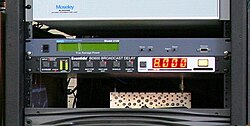Broadcast delay
In radio and television, broadcast delay refers to the practice of intentionally delaying broadcast of live material. A short delay is often used to prevent profanity, bloopers, violence, or other undesirable material from making it to air, including more mundane problems such as technical malfunctions or coughing. In this instance, it is often referred to as a seven-second delay or profanity delay.
Longer delays can also be introduced, often to allow a show to air at the same time for the local market as is sometimes done with nationally-broadcast programs in countries with multiple time zones. That can sometimes be simply achieved with a video tape recorder or similar technology. In the context of modern digital video recorders, this can now be considered a class of time shifting. In this instance, it is often called a tape delay or west-coast delay in the United States, so-called because special events (including award shows) broadcast live in the rest of the US are often tape-delayed on the west coast. This includes Southern California (with the exception of the Academy Awards, which airs live in Los Angeles and the rest of the west coast), despite the fact that Southern California is where many live televised events (American Idol, Dancing With The Stars) take place.
Tape delay also refers to the process of broadcasting an event at a later scheduled time. This is because either a scheduling conflict prevents a live telecast, or a broadcaster seeks to maximize ratings by airing an event in a certain timeslot. A prominent example of the latter is coverage of the Olympic Games, when a broadcaster televises a high-profile event to air in prime time, even though that event is being shown at the "wrong time" because it actually took place when fewer people are likely to be at the TV. Sporting events aired on tape delay are often edited down for time considerations, highlighting the most interesting portions of the event.
Early use
The radio station WKAP in Allentown, Pennsylvania, introduced a tape delay system consisting of an external playback head, which was spaced far enough away from the record head to allow for a five-second delay. A system of rollers guided the tape over the playback head before it wound up on the take up reel. This system was introduced in 1952 when WKAP started a talk show called "Open Mic". It is believed that this was the first time a telephone call-in show was broadcast with the telephone conversation "live" on the air. The FCC rules at the time prohibited the broadcasting of a live phone conversation. However, there was no rule prohibiting a taped playback of a phone call, provided that a "beep" tone was heard by the caller every 15 seconds so that the caller knew he was being recorded. The five-second delay constituted a "taped" phone conversation, thus complying with FCC regulations, that being a legal fiction.
The broadcast profanity delay was invented by C. Frank Cordaro (July 13, 1919 - February 20, 1997) who was Chief Engineer of WKAP, originally on AM 1320, in Allentown, Pennsylvania during the 1950s and early 1960s. Ogden Davies, then General Manager of WKAP, assigned Cordaro the task to develop a device whereby profanity during a "live" conversation could be deleted by the radio talk show host before it was broadcast. This new device was to be used on the "Open Mic" radio talk show. The device Cordaro developed was the first tape delay system. WKAP was one of several stations owned by the Rahal brothers of West Virginia (later Rahal Communications). First tested and used at WKAP, this tape system for broadcast profanity delay was then installed at the other Rahal-owned radio stations. From the Rahal brothers stations, the broadcast profanity delay went into common usage throughout the US.
John Nebel, who began a pioneering radio talk show in New York city in 1954, was one of the early users of a tape delay system.
Computerized delay

In 1977, the capacity of RAM (random-access memory) had reached 16kb (kilobits) per chip, enough to think about using computerized, digital audio means to create a sufficient delay for content deletion. By storing audio digitally, it was possible to move a "virtual tape head" along recorded audio. Eventide, Inc. created the first digital broadcast delay for this purpose. The device (known colloquially as a "dump box") had a large "DUMP"/"DELAY DUMP" button that would bring the delay to zero, thus removing unwanted segments. In addition to this convenience, it would also "rebuild" the delay time by unnoticeably lengthening the normal pauses in spoken material. Thus, a minute or so later, the broadcaster would again have full delay, often leaving the listener unaware that material had been deleted.
In modern systems, a profanity delay can be a software module manually operated by a broadcast technician that puts a short delay (usually between five and ten seconds) into the broadcast of live content. This gives the broadcaster time to censor the audio (and video) feed. This can be accomplished by cutting directly to a non-delayed feed, essentially jumping past the undesired moment (something that can be quite jarring to a viewer or listener). In other cases, dedicated hardware units similar to the original digital unit but with improved quality and editing capability can be used. These products can even "build up" delay with difficult program material such as music. Alternatively, a bleep noise or other substitute sound can be inserted. This is more difficult to do with live content, however, and more often appears on recorded material.
See also
- Bleep censor
- Effects of time on North American broadcasting
- Federal Communications Commission
- Pixelization
- Radio edit
- Music censorship
